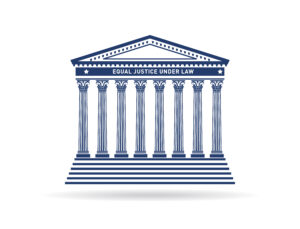How The Newest Supreme Court Justices Compare: A Look At Each Of Their Respective First Two Years On The Court
Overall, these justices reflect the ideological spectrum of the Supreme Court.

For 11 years between 1994 and 2005, there was no turnover in membership on the Supreme Court. There were four changes to the Court’s composition between 2005 and 2010, and then another four changes between 2017 and 2022. Of the four newest justices on the Court, three were appointed by President Trump and one by President Biden.
In the most recent Supreme Court term, Justices Neil Gorsuch, Amy Coney Barrett, Brett Kavanaugh, and Ketanji Brown Jackson significantly influenced rulings with broad implications. The conservative supermajority, including Gorsuch, Barrett, and Kavanaugh, limited federal regulatory authority, restricted prosecutorial discretion, and expanded presidential immunity. Gorsuch, a libertarian, advocated for strict limitations on agency power and supported overturning the Chevron doctrine. Barrett, while often aligned with conservatives, showed independence in dissenting on obstruction statute interpretations related to January 6. Kavanaugh, seen as more of a moderate on the right, pragmatically supported federal limits while maintaining certain rights.

Thomson Reuters' Claims Explorer: A Powerful Tool For Legal Claim Identification

Justice Jackson, the only Biden appointee, represents a progressive counterpoint. Her dissents emphasize civil liberties and deference to longstanding legal protections, particularly in administrative law. Jackson’s concurrence on the obstruction statute reflected her commitment to statutory interpretation and a restrained judicial role, indicating her willingness to collaborate across ideological lines.
Now a look back at the differences in their first terms on the Court which is the focus of the remainder of this article.
Justice Jackson
Justice Ketanji Brown Jackson’s debut term on the Supreme Court was dynamic, marked by her deep involvement and distinctive voice in oral arguments and written opinions. Her presence reshaped the bench’s rhythm, frequently questioning the impact of legal arguments on marginalized communities and historically underrepresented groups. Known for her rigorous, probing inquiries, she navigated complex cases with pointed precision, especially in decisions surrounding affirmative action and voting rights.
Sponsored

Thomson Reuters' Claims Explorer: A Powerful Tool For Legal Claim Identification


Curbing Client And Talent Loss With Productivity Tech

Tackling Deposition Anxiety: How AI Is Changing The Way Lawyers Do Depositions
Law Firm Business Development Is More Than Relationship Building
She brought her legal prowess to significant cases shaping the future of education and electoral authority. In Students for Fair Admissions v. North Carolina/Harvard, she pushed for race-conscious admissions policies, highlighting the role such policies play in countering historic inequities, particularly for disadvantaged communities. In Moore v. Harper, she joined a majority in rejecting the “independent state legislature theory,” which could have sharply increased state legislatures’ power over elections, a decision seen as a reinforcement of judicial checks on electoral processes. Both cases spotlighted Jackson’s approach to interpreting the law in ways that reflect constitutional protections for equality.
Justice Barrett
In specific cases, Barrett joined other conservative justices in several pivotal rulings that reinforced free exercise rights, property rights, and the separation of powers. In Roman Catholic Diocese of Brooklyn v. Cuomo, the Court ruled in favor of religious groups challenging COVID-19 restrictions on worship, while in Fulton v. City of Philadelphia, it upheld the rights of Catholic Social Services in a dispute over foster care services. Moreover, the Court underscored protections for property rights in Cedar Point Nursery v. Hassid, preventing union access to private land, and affirmed presidential removal power in Collins v. Yellen. Barrett’s presence influenced a clear majority that consistently leaned toward conservative interpretations, disproving the theory of a fractured Court and showing unity among the justices on key constitutional principles.
Justice Kavanaugh
Justice Brett Kavanaugh’s first Supreme Court term solidified his conservative stance. In key cases, he joined with conservatives to restrict federal court intervention in partisan gerrymandering and supported adding a citizenship question to the 2020 census. Kavanaugh also backed limits on abortion in a Louisiana case and opposed a death row inmate’s appeal regarding lethal injection pain.
Sponsored

Luxury, Lies, And A $10 Million Embezzlement
Law Firm Business Development Is More Than Relationship Building
His rulings often emphasized reducing federal agency power, as seen in Gundy v. United States and Kisor v. Wilkie, where he sought to limit agencies’ regulatory authority. Kavanaugh occasionally aligned with liberal justices, as in allowing an antitrust case against Apple and advocating for a fair trial in a race-charged jury selection case, though his decisions overall underscore a reliably conservative judicial approach.
Justice Gorsuch
Justice Neil Gorsuch has established himself as a strong textualist on the Supreme Court, following in the footsteps of Justice Antonin Scalia. His opinions emphasize strict adherence to legal texts and a restrained judiciary, evident in his inaugural decision in Henson v. Santander Consumer USA, where he affirmed the role of the judiciary as interpreters of the law.
Gorsuch has voiced concerns about federal overreach and the preservation of states’ rights. In a dissent on federal courts exercising authority over state law claims, he criticized the erosion of boundaries between state and federal power. He also defended individual rights in cases like Minnesota Voters Alliance v. Mansky, where he questioned the state’s authority to restrict voter attire, and NIFLA v. Becerra, where he challenged California’s mandate on private advertising of state services.
Issues and Votes
* Case coding was derived from the most recent iteration of the United States Supreme Court Database.

Justice Gorsuch’s early years demonstrate a commitment to conservative principles, particularly in First Amendment and union-related cases, aligning him with the Court’s conservative ethos on free speech and limiting government intervention. However, his higher dissent rates in criminal procedure (35.29%) and economic activity cases (19.44%) reflect a libertarian approach, prioritizing individual rights over state or federal authority. His dissents regarding judicial power (19.35%) further underscore his willingness to diverge from the majority in advocating for limited government reach.
Justice Kavanaugh had a strong majority presence on high-stakes issues, with a 100% majority vote in cases involving economic activity and federalism. His pattern reflects a tendency to uphold existing federal authority and prioritize stability in economic regulations. His dissent rates in civil rights (23.81%) and judicial power cases (23.08%) indicate a willingness to question the Court’s majority when individual liberties or judicial authority are at stake, but his overall alignment signifies a stabilizing influence within the conservative wing.
Justice Barrett was frequently in the majority across various issue areas, including civil rights and criminal procedure, signaling her alignment with the Court’s conservative leaning. She supported the majority in over 88% of First Amendment cases and 95% of civil rights cases, indicating a tendency to uphold conservative interpretations impacting individual liberties. Her limited dissents, particularly in economic activity (13.64%) and criminal procedure (11.54%), suggest occasional divergence from the majority, yet her votes favored foundational issues like federalism and judicial power.
Justice Jackson’s voting record reflects a more mixed alignment with the Court’s majority. Her higher dissent rates in criminal procedure (40.91%) and economic activity (23.33%) suggest a progressive inclination toward individual rights. While she aligned with the majority in many civil rights (76.19%) and First Amendment cases (87.5%), her pattern indicates an openness to dissenting against the Court’s majority, particularly in criminal justice and economic regulations, positioning her as a leftward influence on the Court.
Authorships By Issue Area

Gorsuch and Kavanaugh frequently addressed arbitration issues, particularly in employment disputes. Gorsuch authored two opinions on labor-related arbitration, while Kavanaugh’s focus was broader, indicating a conservative approach that limits litigation and promotes private dispute resolution. In contrast, Jackson and Barrett engaged with arbitration cases only once.
In criminal law, Gorsuch and Kavanaugh wrote opinions on the death penalty’s constitutionality, underscoring their conservative stance on sentencing. Jackson focused on defendants’ rights and protections, while Barrett addressed double jeopardy.
Gorsuch and Barrett also authored opinions related to administrative law and federal preemption, advocating for restricted administrative authority and state sovereignty. Gorsuch expressed skepticism of expansive federal power, contrasting with Jackson and Kavanaugh, who did not author opinions in this area.
Kavanaugh stood out with multiple opinions on First Amendment issues, while Gorsuch’s rulings on the Freedom of Information Act (FOIA) showed his commitment to transparency. Jackson demonstrated her concern for accountability through civil rights cases.
Jackson and Gorsuch engaged with interstate conflict issues, with Jackson covering federal matters like veterans’ rights and bankruptcy, while Barrett’s scope was more limited. Gorsuch and Kavanaugh also addressed intellectual property, with Gorsuch focused on patents and Kavanaugh on copyrights.
The majority opinions authored by Justices Gorsuch, Kavanaugh, Barrett, and Jackson reveal distinct, yet sometimes similar judicial philosophies (at least for Trump’s nominees). Gorsuch’s opinions relied on constitutional protections and statutory interpretations, frequently in cases related to the Fifth and Sixth Amendments. Jackson’s opinions reflected a commitment to individual rights and procedural fairness, citing the same amendments and engaging with the Federal Arbitration Act and FOIA.
In contrast, Kavanaugh dealt more with First Amendment issues in his opinions, examining speech and the judiciary’s role in adjudicating federal matters. Barrett’s decisions reflect a practical approach to statutory frameworks, focusing on administrative law and governmental accountability.
Overall, Justices Gorsuch and Jackson had more attention in their majority authorships on constitutional rights, while Justices Kavanaugh and Barrett address broader societal implications and regulatory frameworks, highlighting their distinct responses to contemporary legal challenges.
Concluding Thoughts
In examining the decisions of Justices Jackson, Barrett, Gorsuch, and Kavanaugh over their initial two years on the Supreme Court, distinct patterns emerge that highlight their differing judicial philosophies and priorities. Justice Jackson, as the newest member of the Court, has demonstrated a strong commitment to civil rights and due process, often aligning with majority opinions in cases involving these areas. Her judicial approach reflected a focus on the nuances of criminal law and the implications of sentencing, showcasing a propensity to advocate for the rights of individuals within the justice system.
In contrast, Justice Barrett’s voting patterns suggested a more traditional conservative approach, with a notable emphasis on federal taxation and economic activity. Although she consistently voted in the majority, her willingness to dissent in cases concerning the First Amendment illustrates a complex engagement with free speech issues. This contrasts with Justice Gorsuch, who, while also exhibiting conservative tendencies, showed a more libertarian inclination in areas like habeas corpus and judicial power. His opinions reflected a commitment to protecting individual liberties against government overreach, often positioning him as a vocal advocate for defendants’ rights.
Justice Kavanaugh’s decisions exhibited a blend of conservative principles with an occasional bridging approach across ideological lines. While he frequently aligned with the majority in cases concerning civil rights and economic activity, his moderate dissenting votes indicated a willingness to challenge the status quo when he perceives a significant impact on judicial authority or individual rights.
Overall, these justices reflect the ideological spectrum of the Supreme Court. Their respective experiences underscore the complexities of navigating legal precedents and the interpretation of constitutional principles in an increasingly polarized judicial landscape.
Adam Feldman runs the litigation consulting company Optimized Legal Solutions LLC. For more information write Adam at [email protected]. Find him on Twitter: @AdamSFeldman.







